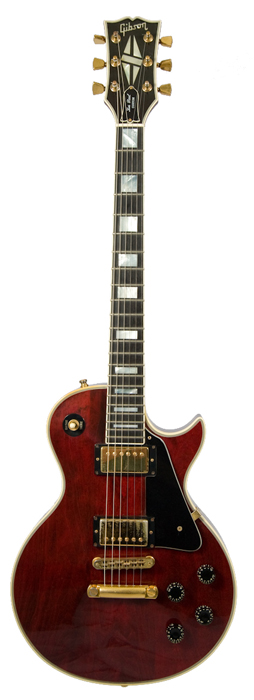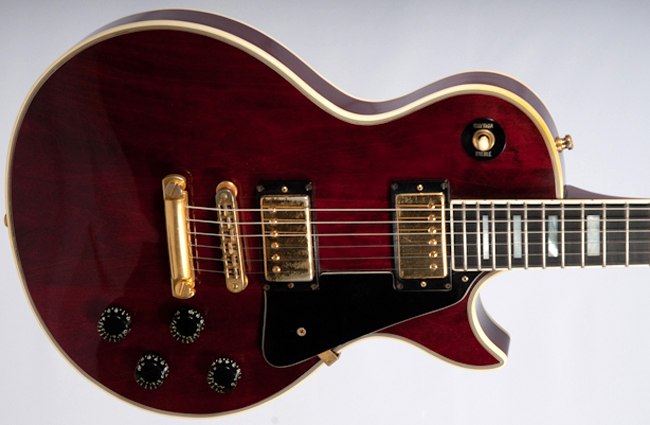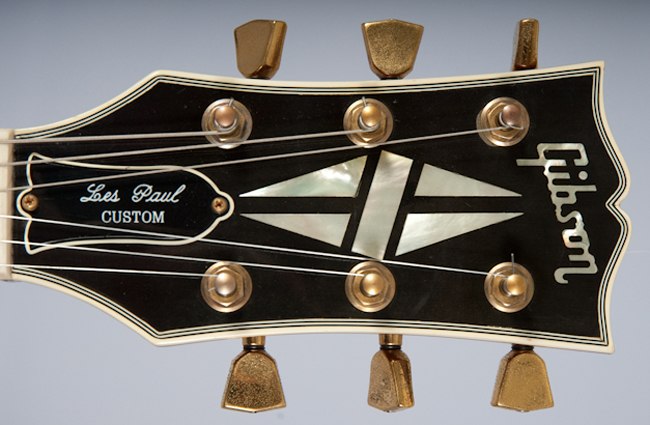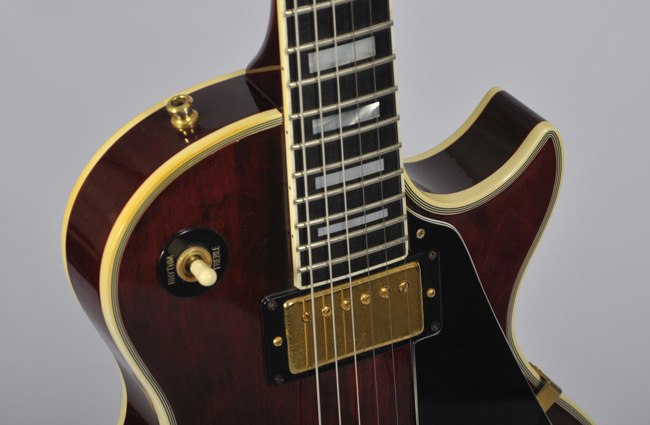Gibson Les Paul Custom
 Year: 1979
Year: 1979
Finish: Wine Red
Origin: USA
Price Paid: $700
Mods: Bone nut, Schaller straplocks
Acquired: 1989
Still owned: No
The Story:
In high school, I told my parents I wanted to learn how to play guitar. Of course, that means getting a guitar — but they called my bluff and said “use your sister’s.” It was a nylon-string folk guitar by Framus (similar to this one), thoroughly inadequate for rocking. I said I wanted an electric. “If you want an electric, you’re going to have to save up and buy it yourself.”
Mom didn’t think I’d do it. To scratch the itch, I borrowed a friend’s Strat copy — a little-known but well-built Asian brand called Yakima — for about seven months while saving up my cash from my job at the record store. My goal was to get a bright red, real Fender Stratocaster — albeit a 1957 reissue from Japan, much like this one. I’d visited Chet’s Music Store, which was a Fender dealer but didn’t regularly stock anything, and was told to come in when I had $600, which would be enough up front for them to order the $1000 model. Chet was a friend of the family, and while there was no deal to be cut, he was friendly and understood my enthusiasm.
The day after I graduated high school in 1989, I took my $600 in savings and asked my parents to go with me to Chet’s — it was a special moment and I wanted them to be there. Partly that was to rub their noses in it, but my parents didn’t even seem to care that I’d called their bluff; they were happy that I had saved my money and kept focused on a goal for such a long time.
Chet said “Today’s the day, huh? Okay, but before we place the order, I have something I want to show you…” And from behind the counter, he produced a 1979 Les Paul Custom, all original, in a hardshell case. Now, I knew the name, and I’d read by battered copy of the UK instructional manual Play Rock Guitar enough to know what a Les Paul was, but…well, it was almost perfectly wrong. Stratocasters were light and hourglassy and had stinging, biting tone. Les Pauls were chunky and heavy and sounded similarly fat. It was exactly the opposite of what I wanted, of everything I’d been saving for.
“Ooh, that’s pretty,” said my mom. She knew of Les Paul from his multitracked hits with Mary Ford, and their television and radio appearances. I just knew him as the guy whose name was on the guitar. And I had to admit, the wine red finish with the gold hardware was pretty.
We went into one of the student rooms and plugged it into an ancient Fender combo amp. I had meager skills at this point, but my mom asked if I could play Chet Atkins’ version of “Snowbird.” My dad commented that it was lovely and that Chet wouldn’t steer me wrong; if I liked it, I could trust him. I knew I was holding something valuable, but again…it wasn’t my guitar, was it? It had a tiny little bit of buckle rash but otherwise looked perfect. It had barely been played. Chet said he’d sold it to a customer some years back who wound up keeping it in his closet and, when that guy needed money, Chet was a pal and bought it back from him. But Chet wasn’t a high-priced guitar dealer; he made money from lessons. He wanted this thing out of his store for the insurance reasons alone. If I bought it for $700, I’d be doing him a favor, he said.
I looked at my dad. “I don’t think you should pass this up,” he said. He knew nothing about guitars, but as a veteran bargain hunter, he knew a good deal when he saw it. “If you don’t like it, you can always sell it or trade it for something else.” So in the back of my mind, that’s always what I’ve considered doing. I mean, who keeps their first guitar, right?
My parents loaned me the extra $100 — “you saved up the first $600, so we know you’re good for it,” said my mom — and I walked out with it in its heavy hardshell case, almost in shock. I didn’t have that “OMG this is the guitar I’ve always dreamed of” feeling. I had that “what have I done?” feeling. And a little voice in the back of my head said, “This had better go up in value, because I want to get a really nice Strat for it.”
Friends said they’d never seen a guitar like it. It was actually not that uncommon; wine red was (and still is) a standard Gibson finish and it was pretty popular at the time it was made. But not in Trenton, New Jersey, apparently, because I got nothing but suggestions that it was unique or rare.
The gold on the hardware has worn away in places, the white binding has turned yellow/orange, and there are more than a few buckle scrapes on the back now. Still, it’s in great shape overall; no damage, all original hardware (except for the strap pegs — Chet was the one who turned me on to strap locks as well as “the toothpick trick”), and the pickups still have strong output. I found its twin for $3000 a year or so ago, and I believe the value will only go up. Guess my dad was right.
Chet’s Music Store was destroyed in a fire some years back; I understand that Chet himself has passed on now too. But I kept the guitar for 25 years, ultimately selling it to a friend to help fund my first home. It wasn’t that valuable, but it put a good dent in the down payment. I loved playing this guitar for two and a half decades and I have no regrets.
Oh, and that 1957 Strat issue from Japan? It might be worth close to $2,000 today, as the made-in-Japan Fenders of that era are now prized by collectors. But I took care of that red Strat craving anyway…






